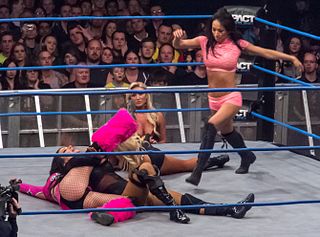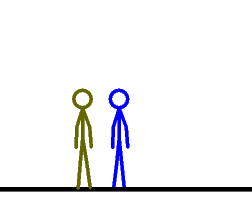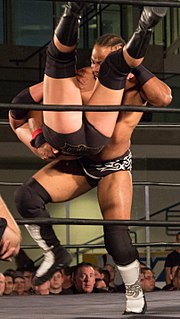Types of cradles
There are many ways to counter the cradle and many variations to the cradle maneuver. For example, there is the near-side cradle that is done by a wrestler grabbing the leg of the opponent that is closest to him and then wrapping and locking that with the opponent's neck.
There are also a few other cradles. A few examples would be the "far side cradle", the "standing cradle", "clap cradle"; then there is the formidable "leg cradle". The far side cradle is executed by laying perpendicular to your opponent while he is lying belly-down, then take the hand closest the opponent's legs and plant it in between the opponent's legs and crossface him with the other arm, then scrunch him together in the two directions which allows your hands to grip together (this would be on the far side of the opponent, hence the name far side cradle). Then you dig your knee into your opponent's butt and lean back to get him to his back. Another thing you can do when performing a far side cradle is to dig your head into your opponent's head and squeeze the neck with your arms, dig your closest knee to the opponent, into their side, and then take your free leg and hook their free leg and pull it down to the mat (but not so it is potentially dangerous). Doing this during the far side cradle adds pressure and pain to the opponent so they do not put up as much of a fight.
Another one of the above cradles is the standing cradle. This is usually performed after taking an outside leg shot (outside sweep) and pulling the leg up, with your arms in between the knee, and you standing to the outside of them. Once you stand up with the leg, get your arm that is nearest the foot of the leg you have, and get it to the outside of the leg, so now both of your arms are parallel and touch each other. Now take your other arm, that you have done nothing with yet, other than taking a shot with, and let go of the leg with that arm and put it around their neck. Then start pulling your arms together so that they can form a grip, and once they do that, trip them backward slowly. Once they hit the mat, you can perform the additional moves into this cradle, as it is now a far side cradle.
The clap cradle is just like the standing cradle, except more violent and faster. You perform the standing cradle all the way up to the part where you get your free arm around the opponent's neck, then you quickly clap your hands together to form a grip, and trip the opponent quickly to the mat, where you can perform the same moves to the head, side, and leg.
The last of these cradles is the leg cradle. This is a great move to watch, and once you put it on an opponent, there is almost no coming out of it, as your legs are the strongest parts of your body. To get to the leg cradle, you should get to a near side cradle position, and start pulling your arms in together for the grip to be set. But before you set your grip, throw your legs in on the sides that the leg corresponds to with the hand (you have your right hand on the head, put the right leg on the head, vice versa for the other leg and position). Once you get this, hook your feet together and lean forward. Now the rest is obvious, as he is on his back, and all you need to do is adjust for the pin.
Professional wrestling throws are the application of professional wrestling techniques that involve lifting the opponent up and throwing or slamming them down. They are sometimes also called "power" maneuvers, as they are meant to emphasize a wrestler's strength. Many of these moves are used as finishers by many wrestlers. Many maneuvers are known by several different names. Professional wrestlers frequently give their "finisher" new names that reflect their gimmick. Moves are listed under general categories whenever possible.
Professional wrestling holds include a number of set moves and pins used by performers to immobilize their opponents or lead to a submission. This article covers the various pins, stretches and transition holds used in the ring. Some wrestlers use these holds as their finishing maneuvers, often nicknaming them to reflect their character or persona. Moves are listed under general categories whenever possible.
A suplex is an offensive move used in amateur wrestling and professional wrestling. It is a throw that involves lifting the opponent and bridging or rolling to slam the opponent on their back.
Aerial techniques, also known as "High-flying moves" are maneuvers in professional wrestling using the ring's posts and ropes as aids, in many cases to demonstrate the speed and agility of smaller, nimble and acrobatically inclined wrestlers preferring this style instead of throwing or locking the opponent. Due to injuries caused by these high risk moves, some promotions have banned the use of some of them. The next list of maneuvers was made under general categories whenever possible.
Strikes are offensive moves in professional wrestling, that can sometimes be used to set up an opponent for a hold or for a throw. There are a wide variety of strikes in pro wrestling, and many are known by several different names. Professional wrestlers frequently give their finishers new names. Occasionally, these names become popular and are used regardless of the wrestler performing the technique.

In professional wrestling a pin is achieved by holding an opponent's shoulders to the mat for a three count, for a pinfall which will win the match for that person or team.
In professional wrestling double-team maneuvers are executed by multiple wrestlers instead of one and typically are used by tag teams in tag team matches. Many of these maneuvers are combination of two throws, or submission holds. Most moves are known by the names that professional wrestlers give their "finishing move" names. Occasionally, these names become popular and are used regardless of the wrestler performing the technique. Moves are listed under general categories whenever possible.

The Boston crab is a professional wrestling hold that typically starts with one wrestler lying in a supine position on the mat, with the other wrestler standing and facing him. It is a type of spinal lock where the wrestler hooks each of the opponent’s legs in one of his arms and then turns the opponent face-down, stepping over him in the process. The final position has the wrestler in a semi-sitting position and facing away from his opponent, with the opponent’s back and legs bent back toward his head. The original name for the maneuver was the Backbreaker, before that term became known for its current usage. In modern wrestling, the Boston crab is not treated as a lethal submission maneuver, even though it was considered a match-ending hold in the past.

A piledriver is a professional wrestling driver move in which the wrestler grabs their opponent, turns them upside-down, and drops into a sitting or kneeling position, driving the opponent head-first into the mat. The technique is said to have been innovated by Wild Bill Longson.

A powerbomb is a professional wrestling throw in which an opponent is lifted and then slammed back-first down to the mat. The standard powerbomb sees an opponent first placed in a standing headscissors position. He is then lifted on the wrestler's shoulders and slammed down back-first to the mat. A prawn hold is commonly used for a pinning powerbomb.

In professional wrestling a DDT is any move in which the wrestler has the opponent in a front facelock/inverted headlock, and falls down or backwards to drive the opponent's head into the mat. The classic DDT is performed by putting the opponent in a front facelock and falling backwards so that the opponent is forced to dive forward onto their head. Although widely credited as an invention of Jake Roberts, who gave the DDT its famous name, the earliest known practitioner of the move was Mexican wrestler Black Gordman, who frequently performed it during the 1970s.

A backbreaker refers to professional wrestling moves which see a wrestler dropping an opponent so that the opponent's back impacts or is bent backwards against a part of the wrestler's body, usually the knee. The standard version of the move sees the wrestler scoop their opponent horizontally before dropping to one knee, slamming the opponent's back on their other knee.
In professional wrestling, a neckbreaker is any throw or slam that focuses its attack on the opponent's neck. One type of neckbreaker involves the wrestler slamming an opponent's neck against a part of the wrestler's body, usually the knee, head or shoulder. The other type of neckbreaker is a slam technique in which the wrestler throws an opponent to the ground by twisting the opponent's neck. This also refers to a "back head slam" where a wrestler drops to the mat while holding an opponent by their neck.
Kimarite are winning techniques in a sumo bout. For each bout in a Grand Sumo tournament, a sumo referee, or gyōji, will decide and announce the type of kimarite used by the winner. It is possible for the judges to modify this decision later. Records of the kimarite are kept and statistical information on the preferred techniques of different wrestlers can be deduced easily. For example, a pie chart of the kimarite used by each sekitori in the past year can be found on the Japan Sumo Association webpage.

A brainbuster is a professional wrestling throw in which a wrestler puts the opponent in a front facelock, hooks their pants or thigh, and lifts them up as if they were executing a vertical suplex. The wrestler then falls onto their back so that the opponent lands on their head while remaining vertical. This move is a version of the DDT. It was innovated by Killer Karl Kox. In Japanese puroresu, the term "brainbuster" refers to a regular vertical suplex, while the move elsewhere known as a brainbuster is referred to as a "vertical drop brainbuster". The brainbuster is banned in WWE because the person receiving the move will land on the top of their head or neck without protection. The botched executions of the belly-to-belly piledriver by Owen Hart and The Undertaker led to changes in the wrestling style of two comparable wrestlers, specifically Stone Cold Steve Austin and Goldberg, respectively, with the former changing from a technician to a brawler and the latter introducting an alternative to his Jackhammer finisher by debuting a brainbuster at the Super ShowDown of 2019 in Saudi Arabia.

A nelson hold is a grappling hold which is executed from behind the opponent, generally when both are on the mat face down with the opponent under the aggressor. One or both arms are used to encircle the opponent's arm under the armpit, and secured at the opponent's neck. Several different nelson holds exist, and they can be separated according to the positioning of the encircling arm(s). A nelson is used to control an opponent or to turn him over on his back and execute a pin.

A grappling hold, commonly referred to simply as a hold and in Japanese referred to as katame-waza, is any specific grappling, wrestling, judo or other martial arts grip that is applied to an opponent. Holds are principally used to control the opponent, and to advance in points or positioning. Holds may be categorized by their function such as clinching, pinning or submission, while others can be classified by their anatomical effect: chokehold, joint-lock or compression lock.
A facebuster, also known as a faceplant, is generally a takedown move in professional wrestling in which an attacking wrestler forces their opponent down to the mat face-first without involving a headlock or facelock. A standard facebuster, also known as a jumping facebuster, involves the wrestler grabbing hold of the opponent's head/hair and dropping down to their knees, forcing the opponent's face into the mat.
A powerslam is a professional wrestling body slam move in which the wrestler performing the slam falls face-down on top of his/her opponent. The use of the term "powerslam" usually refers to the front powerslam and the scoop powerslam.

A pin, or fall, is a victory condition in various forms of wrestling that is met by holding an opponent's shoulders or scapulae on the wrestling mat for a prescribed period of time. This article deals with the pin as it is defined in amateur wrestling.










